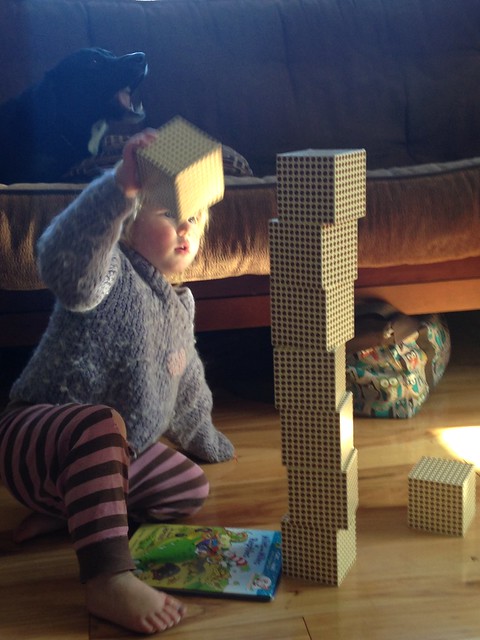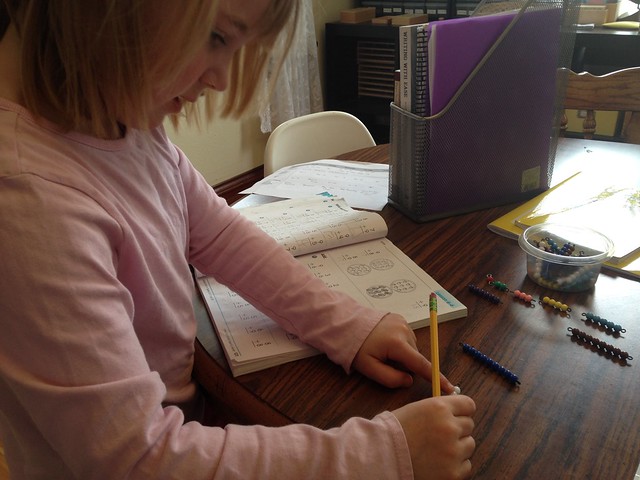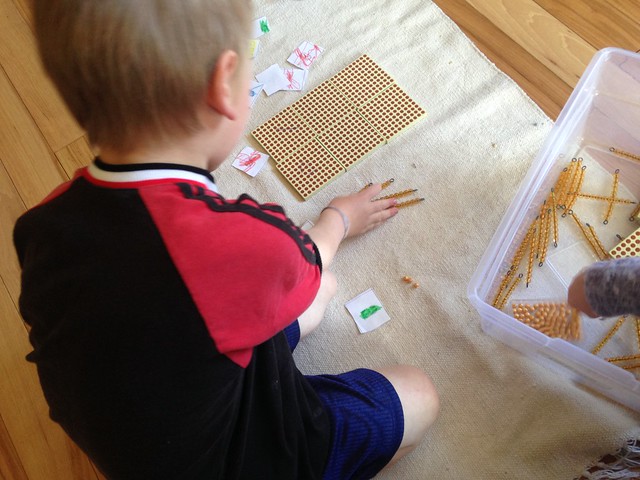One of the challenges of using Montessori at home with a large family has been tracking everyone and presenting lessons consistently. I’ve used many different schedules to keep things moving and on track, but every other minute it seems someone is transitioning into a new sensitive period or plane of development. Then life happens and I’m left with out anyone to pick up the pieces when I’m on extended bed rest or in the hospital, or whatever else. I currently have four needing regular lessons. For subjects that I can’t combine, such as math. I end up with either hours of lesson presenting on math day, or splitting up math so that I have to do multiple subjects in a day which is a another mental nightmare.
Right around Christmas last school year (2013), I switched Aidan to Math U See, beginning with Epsilon for fractions. This was a smooth transition for him as he was proficient in all of his operations and basic facts. I thought about starting Caleb with MUS this past fall, but he wasn’t at a point that would make the transition as smooth as it was for Aidan so I didn’t do it.
While Math U See is definitely based on the Montessori approach to Mathematics, they use a different scope and sequence that makes transitioning more challenging prior to Epsilon. Fractions and decimals are traditionally E2 (9-12 year old) topics of study, following the completion of concrete to abstract, static and dynamic, in all four operations. Thus transitioning right at this point makes a lot of sense. Prior to Epsilon (recommended for around 5th grade), MUS uses a different scope and sequence (but similar approach) to teaching addition and subtraction (covered between 1st and 2nd grade), multiplication (3rd grade), and division (4th grade). Instead of starting with place value to the thousands, they use a more basic facts to single digit to multi digit, traditional approach. They just do it all with one operation before moving on to the next. (I’m really simplifying here, for the purposes of those who are not familiar with MUS.)
Enter this school year, when I ended up frantically ordering math workbooks for Caleb and Kylee because I needed something that could be taught by anyone. That someone else could assign and correct.
I hated them.
They hate them.
Half the time, we end up pulling out the materials to teach whatever concept they are working on anyways. Our box of bead bars (with and without the checkerboards) and working charts have seen the most use.
Looking forward to next school year, I decided to test a theory. What if I took the MUS curriculum and used it as my scope and sequence through the Montessori materials? For the younger students, I wouldn’t even need the instruction pack because I already have the materials and knowledge for the Montessori way to teach the concepts. I also wouldn’t need the MUS manipulatives as we already have a complete set of Montessori materials. (There is a new digital version of the MUS manipulatives, which I may consider in the future.)
Using the MUS student packs, however, would save me from needing to record-keep who was where in the albums (those of you with albums can imagine the challenge of having 4 kids in 3 completely different albums and trying to flip between all of them and track this- even with electronic albums it is a nightmare). The student work texts would also save me the physical space of needing to have equation drawers for everything from every level that I am teaching, thus saving space.
I really like the MUS student workbooks because they have relatively few problems per lesson even at the higher levels and there is plenty of space for writing and no visual distractors (which is a must for my autistic child). I also like that for each new lesson there are 7 different work pages, 3 to practice only the new concept, 3 to review previous concepts, and 1 with an application and enrichment that ties to something like graphing, problem solving techniques, ties to music or geometry, etc. When Aidan understands a new concept right away, he will do A (new concept), D (systematic review), and G (application & enrichment) before moving on to the next lesson. When he has a harder time I will assign more. There is also a lesson test for each lesson and intermittent unit tests. I have only used the lesson tests a couple times when I could tell he was really struggling, but I have used the unit tests. With this approach he completed less than half of the Epsilon workbook and I will be able to reuse it for Caleb in a couple years, supplementing as needed with additional practice worksheets printed from the website (see link below).
Since Logan is in that kindergarten age range and asking for lessons, particularly in math, I did a trial run with him. Using only the Additional Practice resource for Primer level, I have been walking Logan through using the materials. (You can find all of the extra resources on this page.) I printed the activities and spiral bound them to make him his own math book…which he absolutely loves! As we come to a concept he doesn’t know or needs review, we go straight to the materials and pull out the appropriate lessons. Below he is cutting out number cards for the “hundred house, tens house, and unit house”. Using the cards from his book (rather than the small number cards) and our golden beads, we introduced place value and making numbers.
Eventually he decided he needed to “trick me” by putting 10 in one category, which tells me he is ready to start the race to 100 game next week (Digital version available in my Teachers Pay Teacher Store). We use traditional lessons as the core, while using the activity book to give him practice with pencil/paper curriculum and help him with transitioning to more independence later. He has enjoyed occasional lessons on patterning and the dot to dot activities.
The Primer Level is not the introductory scope and sequence of Montessori we have used in the past, but it is building a good foundation and I’m pleased with it This lesson/activity came right after number sense/counting to 9. We haven’t done anything with teen/ten board nomenclature yet. I think that is coming next. Since I don’t know exactly what the *official* lesson on the hundred, ten, and unit house was, I might be doing this more out of sequence than I think but I am pretty sure it’s all going to work out ok in the end!
My plan for next year is to continue with the additional practice workbooks and the traditional presentations for Primer and probably Alpha with Logan. Kylee will move into Beta using the student instruction packs, our materials, and “live” lessons with me. Caleb will do the same thing with Gamma. They will have daily math practice, focusing on hopefully one lesson/week (roughly the pace Aidan has used). Starting with Epsilon, I will transition them to using the DVD for lesson presentation with only review and support as needed from me.
Now finishing Zeta, Aidan works almost independently in math which frees my time up significantly. Next year he will move into Pre Algebra to set him off on secondary math. I see no reason we wouldn’t continue all the way through Calculus. Several of our local families use Math U See all the way to the end of high school and they are all really pleased with it. I don’t know any other math curriculum that people have been so consistently positive about.
Obviously this application of this curriculum probably only appeals to a very small number of people, but I think it is important to share nonetheless. All Montessori families eventually need to transition to a traditional curriculum (if they continue beyond elementary school), and there is a lot here that could be used to aid in that transition at whatever time it comes.
Math U See, used as designed, is also a great way to incorporate Montessori principles with no Montessori training whatsoever. The blocks are essentially bead bars and even follow an almost identical color scheme. While some of the approaches can be a little tricky to explain because they show the concrete before the abstract (which most adults never learned), the DVD and instructor manual are more than enough to get through! They are also offering an app version of their manipulatives which I have not tried yet. If you have tried it I’d love to hear what you think. There have been a couple times, using the DVD with our Montessori materials, Aidan has been tripped up a bit because it wasn’t quite the same.
The bumps in the road due to our family size make Montessori a challenge at times. Creative solutions such as this, however, have allowed us to continue to offer a high quality education at home while staying as true as possible to the Montessori philosophy.
You can read more of my thoughts on Montessori with a larger family, here.





Great Blog,Keep up the good work.Keep updating.
Preschool In Bangalore